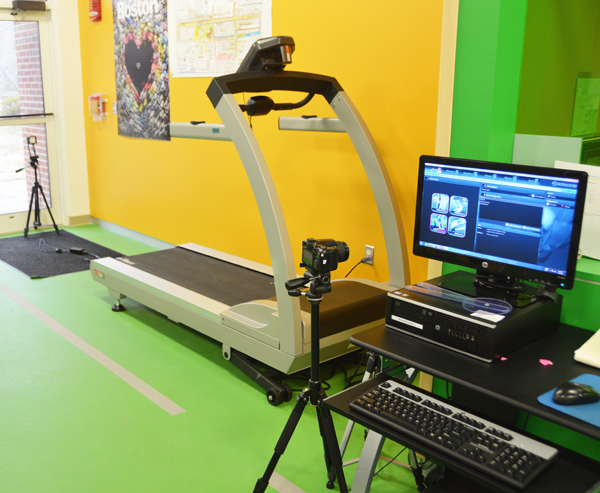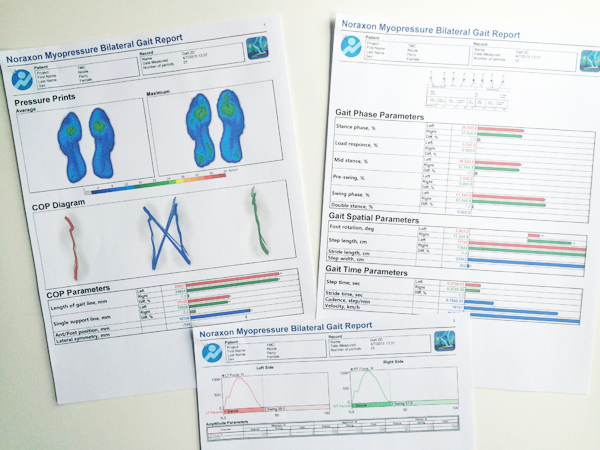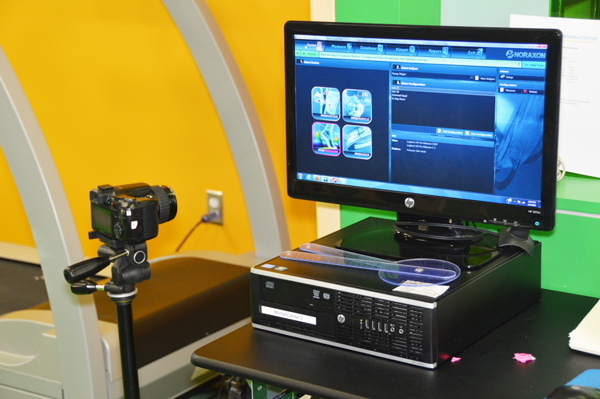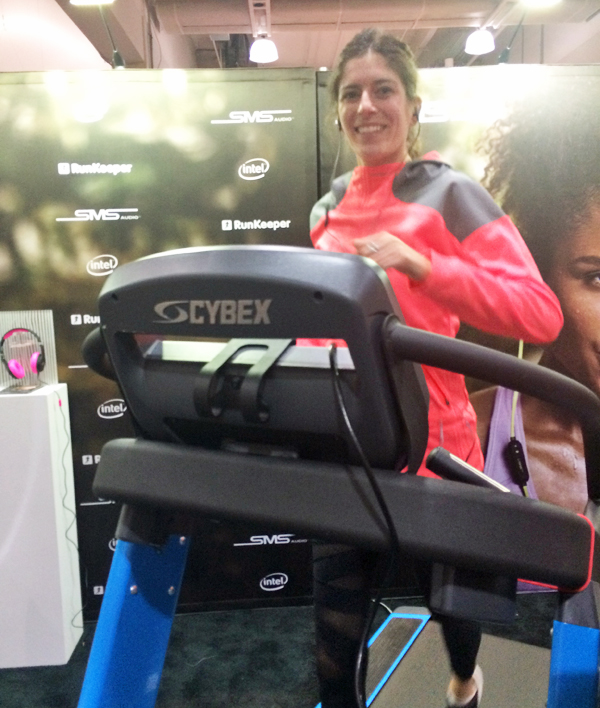 I feel like the theme of April has been running—and not just because of the marathon. A couple weeks ago I had a really fun opportunity to get a runner’s assessment done at the Micheli Center for Sports Injury Prevention. It was awesome! I learned a ton, so fair warning—this post may turn into a novel.
I feel like the theme of April has been running—and not just because of the marathon. A couple weeks ago I had a really fun opportunity to get a runner’s assessment done at the Micheli Center for Sports Injury Prevention. It was awesome! I learned a ton, so fair warning—this post may turn into a novel.
As I’ve mentioned before on the blog, I used to run just about every day but recently it’s fallen to the wayside because it wasn’t feeling good. I had problems with Achilles tendonitis flair-ups from running which I pretty much resolved by switching to a minimalist sneaker, but then I found that my feet would hurt me if I did anything over 6 or 7 miles. I become frustrated and couldn’t see the point in doing something that seemed to be beating up my body. I still run here and there and in shorter bursts, but nothing like I used to (which is sad because I loved running—it was my favorite form of “me time”).
 I did the Running Injury Prevention Quick Start Program, which is a private hour-and-a-half session that identifies inefficiencies in your running gait by evaluating posture, cadence, foot strike, stride, flexibility, movement patterns and muscle imbalances. Based on all that, you then receive instruction on how to improve your running form, and which exercises/stretches will help strengthen and stretch the necessary muscles.
I did the Running Injury Prevention Quick Start Program, which is a private hour-and-a-half session that identifies inefficiencies in your running gait by evaluating posture, cadence, foot strike, stride, flexibility, movement patterns and muscle imbalances. Based on all that, you then receive instruction on how to improve your running form, and which exercises/stretches will help strengthen and stretch the necessary muscles.
You start by answering some basic questions about your running history and getting flexibility and strength measurements. Next up, video is taken of you performing a single-leg squat test and running on a special treadmill equipped with force plates. The treadmill and camera are synced to a computer so that you can watch yourself afterwards (awkward haha) and have your specialist talk you through what you’re seeing. The final part of the assessment is spent going over exercises, stretches and running form corrections that are catered to your individual needs.
I gained a ton of insight from my assessment—not just as a (former?) runner, but as a personal trainer. Even though it was a while ago that I got certified, it was crazy how much this runner’s assessment made things click for me. NASM focuses a lot on imbalances and how to strengthen and stretch the right muscles to correct them. I had a good understanding before, but now that someone has walked me through an assessment of my own muscular imbalances, I feel like I see it with a whole new clarity. It was so beneficial! Why haven’t I done something like this sooner??
Major Takeaways from My Runner’s Assessment
15+ years of tap dancing has had a big impact.
About five minutes into my assessment, my Injury Prevention Specialist, Jen, was like “did you dance growing up?” That obvious. Tap dancing is 90% on the balls of your feet and constantly having my heels lifted has resulted in ridiculously tight calf muscles, shortened Achilles tendons (hence the tendonitis flair-ups I’ve suffered from!), and perma-lifted toes (the top of my foot is tight). Think of what a foot looks like when it’s in a high heel—that’s essentially the shape my foot just naturally wants to assume at all times. I actually lift my toes so much when I run that I usually get holes in the tops of my sneakers! 
Things I need to do to correct my tap dance imbalances:
- Stretch out the top of my foot. I can do this easily by scrunching my toes and rolling the top of my foot onto the ground.
- Foam roll the f**k out of my calves. The F bomb is necessary—when Jen rolled out my caves for me it was literally like I had marbles underneath my skin. After SMR I need to make sure to statically stretch the calves as well.
- Use a resistance band to isolate the shin. I over-use the top of my foot and toes when flexing my foot rather than engaging my shin to lift it. Jen showed me how to flex my foot against a resistance band while keeping my toes scrunched would force me to pull using the shin area rather than the top of my foot.
- Reduce the angle of my foot when I heel strike the ground running. Jen explained that it’s not necessarily a terrible thing that I’m a heel striker when I run, but that it shouldn’t be such a dramatic heel-first landing. If I stop pulling up with my toes so aggressively, the angle with which my foot hits the ground won’t be as bad (and I won’t get holes in the tops of my shoes anymore).
I need to strengthen my hamstrings and glutes/abductors.
When we tested the strength of various muscles during the assessment, it turned out that my quads are much stronger than my hamstrings. To put it in perspective, it should be a 4:3 ratio (quad strength to hamstring strength) and mine is more like 3:1. Just as important as strengthening those muscles is stretching my hip flexors so that their tightness doesn’t inhibit me from activating the glutes and hamstrings properly. I need to do some major TFL foam rolling!
Jen showed me a bunch of resistance band exercises to help with this and I’m going to share a workout inspired by them on the blog soon.
My legs are staying too straight as I run and as a result I’m over-stepping.
 An over-step means that my heel is hitting the ground in front of my knee. I sort of leap as I run instead of creating a smooth pedaling motion with my legs. To fix this, I need to lift my knees a little higher when I run—by adding more of a bend, my foot will hit the ground in a supportive position underneath my knee rather than ahead of it. In the assessment, they had me start by sort of marching in place and then gradually speeding it up into a run in order to practice this.
An over-step means that my heel is hitting the ground in front of my knee. I sort of leap as I run instead of creating a smooth pedaling motion with my legs. To fix this, I need to lift my knees a little higher when I run—by adding more of a bend, my foot will hit the ground in a supportive position underneath my knee rather than ahead of it. In the assessment, they had me start by sort of marching in place and then gradually speeding it up into a run in order to practice this.
I think part of the reason I leap when I run is because I was always told to “lengthen my stride” when playing sports and running cross county in high school. Jen confirmed it’s something they hear a lot. She said to compensate for the couple inches I’m losing in my stride by not over-stepping, I just need to pick up my cadence. The Micheli Center suggests a cadence of 170-180 steps per minute (for longer distance running) and right now I’m at 161.
I need to engage my lower abs when I run to prevent a pelvic tilt.
This is something I’ve been working on for a while in other forms of fitness and everyday movements to help prevent low back pain. But I didn’t realize I was doing it while I ran, too (duh—figures I am!). It’s a common postural imbalance and something I’m always reminding my students of in class—engage your low abs! I think of it as pulling up on a pants zipper—take out any over-arching of the low spine by tucking your tailbone and pulling the lower abdomen in. I know, ladies, your butt does not look as cute when you do this, but trust me, your body (especially your low back) will thank you. 😉 
As far as running shoes go, I should find one with a neutral sole (an even thickness from toes to heel).
While the Micheli Center doesn’t make specific shoe recommendations because there are so many options out there and a lot of it has to do with personal preference, they did suggest I stick to a sole of even thickness because I strike with my heel. I should stay away from shoes that are thick at the heel and gradually get thinner towards the toes.
With all these takeaways, my next challenge is to integrate all this knowledge into my running form without over-thinking it. This past weekend, I hung out at the Intel and SMS Audio booth at the Boston Marathon Expo and was demo-ing their BioSport headphones on a treadmill. It got to the point where I had to just shut off my brain because I found my mind racing with tips from my runner’s assessment: Stop pulling up with your toes so much. Am I over-striding? Lift your knees higher. Engage your abs. Is my heel strike too aggressive?
 Overanalyzing on the treadmill aside, the Expo was a lot of fun—even though I’ve lived in Boston for five years now, it was actually my first time attending! There were countless exhibitors and an overwhelming number of things to see and try. All the excitement actually made me a little sad I wasn’t running the marathon. Next year?? During my time at the Intel & SMS Audio booth, we shot a bunch of video footage so I’ll be sure to keep you posted if I get any face time in the final cut. I tend to dramatically talk with my hands (it’s the Italian in me haha) so I’m guessing I produced a solid blooper reel. And there’s still a chance to win your own pair of BioSport heart rate monitor headphones coming Sunday! In the meantime, you can listen to the playlist of workout favorites Intel has put together on Spotify here.
Overanalyzing on the treadmill aside, the Expo was a lot of fun—even though I’ve lived in Boston for five years now, it was actually my first time attending! There were countless exhibitors and an overwhelming number of things to see and try. All the excitement actually made me a little sad I wasn’t running the marathon. Next year?? During my time at the Intel & SMS Audio booth, we shot a bunch of video footage so I’ll be sure to keep you posted if I get any face time in the final cut. I tend to dramatically talk with my hands (it’s the Italian in me haha) so I’m guessing I produced a solid blooper reel. And there’s still a chance to win your own pair of BioSport heart rate monitor headphones coming Sunday! In the meantime, you can listen to the playlist of workout favorites Intel has put together on Spotify here.
But back to my assessment—I’m now trying to just focus on one thing at a time. To start, lifting my knees a little higher when I run. Next, those dang tap dancing toes ripping holes through my shoes.
If you’re in the Boston area and interested in a runner’s assessment, you can get more info at the Micheli Center’s website. The quick start program I did is $90 and I’d highly recommend it!
Have you had this type of assessment done before? What’d you learn?









I would love to try that out! I’ve gotten a basic test at a running shoe store but I really would like to find out more about my running technique and try and fix the underlying cause of my plantar fasciitis and front of foot pain! Too bad I’m not close enough to where you did it but I’m going to look up some places!
I tap dance too! I always knew my feet were shaped a bit odd from dance, but now that you point out how you lift up your heels, it makes WAY more sense. I’ve been told when I run, I look like a gazelle thanks to dancing 🙁 It used to be a LOT worse (I literally ballet ran in volleyball practice in high school until someone pointed it out haha), but I wonder how else dancing affects running.
I would LOVE to have this work up done- I have a major imbalance where my left side is always super tight, especially after a run. I’ve done a marathon and use to love to run but now, like you, I run 2 days/week and do other things because my body simply hates it.
The shoe thing is kind of interesting to me. I work in running specialty retail and it sounds like the only shoe that would “work” according to what you’ve said would be a zero-drop shoe where your heel and forefoot are on the same plane- but of course these shoes extend your calf and achilles and will just cause further tightness there (of course some folks are able to easily and slowly adjust to this successfully), but I’d never recommend a shoe like this to someone who is already having a lot of achilles and calf stuff.
I kinda thought the same thing, figuring that a thicker sole around the heel would help keep my foot at a downward angle rather than pulling up with my toes. But I’ve been using a very minimalist shoe and find that because I don’t have that cushy heel support to jam into the ground, I actually heel strike less dramatically and stay more on my toes. Who knows! 🙂
Wow, that’s awesome! What a cool idea. I’m not a runner whatsoever, but I would love to do this type of assessment for other types of fitness-related exercises. Do you know of any places in the Boston/Providence area that do fitness assessments (say for strength, power, endurance, etc.)? I would LOVE to know! Have you ever had any other assessments done?
Ellyn we do a more thorough assessment for flexibility, range of motion, strength, power etc at the center as well. It’s an Injury Prevention Evaluation that takes about 3.5 hours. If you’re interested call the center at (781) 373-2760 🙂
I haven’t had other assessments done, but I’d love to after my experience with this running session! Check the other services offered by the Micheli Center (they do other injury prevention outside of running)
I tapped danced competitively, too! Did you compete?
Where’s your pullover from?
It’s from The North Face. I never competed–just lots of recitals 🙂
WOW. I danced for 13 years (jazz and tap), and this may finally explain why I’ve been having so many issues with tight muscles on the lower half of my body. I actually catch myself walking on my toes around the house lol. So thank you for making me feel more normal. Do you know if any other cities offer this? I’m not really a runner (I’ve never been good at it – maybe this is why?), but I’m thinking it may help pinpoint some other issues I’ve been having.
I’m sure you could find something similar in your area! Google injury prevention center/assessment or something along those lines 🙂
Nicole, you did a great job reiterating what we did here! Glad you found it helpful.
I have been working on my pelvic tilt for a while now – it is constant work to remind myself. It really helps my lower back but it’s still not a habit so I have to keep remembering to do it! Good post.
My calves are so tight it isn’t funny. I do foam roll them too and it definitely deserves the F bomb! My god, Nicole, I know the pain you feel! I also stretch the top of my foot and use a stretching band for my shins…I think all the wonderful years of 6 inch heels brought me into a new level of calf tightness. LOL!
Haha I hear ya! My stiletto collection is not helping me out… 😉
So interesting. I would love to have a running assessment done and see if my tap dancing days have had any lasting impacts on my form. Fist bump to all the tap dancers out there!
Great review! I have tight hips, hamstrings & core. I’ve been thinking about an assessment and you’ve inspired me to see if there are any in my area locally!
http://www.casualonthecoast.com
I would love an assessment like this. The closest I have come it when I get fitted for running shoes and it is nowhere near as comprehensive. Thanks for sharing and I will have to check and see if any places around me offer it!
This was so interesting to read! I was a tap dancer for 15 years too, so this makes A LOT more sense now!
I’ve had an assessment done too and it was so enlightening! It’s been a while since I’ve had it done, so I feel like I should have another one – especially since i’ve just gotten over 2 injuries in the last year…I HAVE learned that I am a heel striker, and I also land with my heel in front of my knee – bad bad bad!!! I hope you find your “groove” with running again and fall back in love with it!
Glad to hear I’m not the only one with weak hamstrings! lol
I love the Micheli Center! I went to a conference there a couple years ago and learned so much. I would love to do a running assessment there! Pretty far away from me though 🙁
I keep reading about how helpful clinics like this can be but this post has really made me realize I should suck it up & find one. I’ve been dealing with a lot of tiny nagging injuries-but-not-really and maybe this will be just the thing that gets me on the right track. Thanks!
Wow! That’s so insightful and SUCH interesting information. I just recently started running…can’t run for my whole workout, but I’m getting there. I would LOVE to know how I naturally run and what it means. Thanks for the suggestion!
Saving this! Thanks for sharing – I ALWAYS wear out my shoes because I get holes in the top toe area – so I’m wondering if I suffer the same problems… can’t wait to try out the 4 tips she gave you! I’ve always wondered what type of things would need correcting if I got a runner’s assessment…
I need to do this! I’m starting running/wogging (walking+jogging) again, and I have a tricky left foot that like to walk however it wants.
Try Shoe Armour for the toe hole problem. It prevents toe hole in running shoes. Link below.
http://www.amazon.com/gp/product/B00TGI2JAG